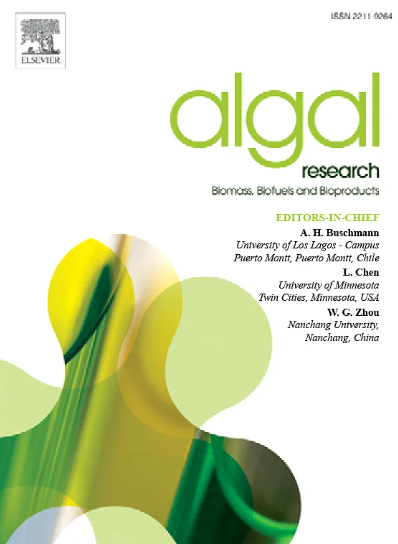Remarkable metabolic reconfiguration due to three classical nitrogen sources in Gracilariopsis lemaneiformis (Rhodophyta)
IF 4.6
2区 生物学
Q1 BIOTECHNOLOGY & APPLIED MICROBIOLOGY
Algal Research-Biomass Biofuels and Bioproducts
Pub Date : 2025-04-26
DOI:10.1016/j.algal.2025.104069
引用次数: 0
Abstract
The macroalga Gracilariopsis lemaneiformis undergoes dynamic nitrogen (N) fluctuations during cultivation, driven by climate change and eutrophication. However, our understanding of how G. lemaneiformis responds to different N environments remains limited. This study investigates the physiological and molecular metabolic responses of G. lemaneiformis to various N chemical forms (ammonium, nitrate, and urea). Our results indicate that G. lemaneiformis preferentially utilizes ammonium, consuming it more rapidly than nitrate and urea. Furthermore, the transcript profiles of N transporters exhibited distinct regulatory patterns between inorganic N and urea. Metabolic flux analysis revealed significant changes under different conditions of N. Notably, ammonium treatment upregulated the expression of photosynthesis-related proteins in PS II and led to an accumulation of amino acids with higher N content, such as arginine and citrulline. In contrast, nitrate treatment downregulated carbon (C) fixation while promoting the accumulation of amino acids with higher C/N ratios, particularly leucine and valine. Urea treatment resulted in elevated levels of polyamines and aromatic amino acids, which displayed the highest C/N ratios. As a result, the overall C/N ratio in G. lemaneiformis corresponded with that of the dominant amino acids across the three N treatments. Our findings revealed that ammonium, nitrate, and urea differentially affect C and N allocation in G. lemaneiformis. Furthermore, strategic use of specific forms of N can significantly enhance the production of industrially valuable metabolites, highlighting the potential of this macroalga as a sustainable resource for aquaculture and nutraceutical applications.

三种典型氮源导致的葛缕冈代谢重构
在气候变化和富营养化的驱动下,大藻细叶茅在养殖过程中经历了动态氮(N)波动。然而,我们对G. lemaneiformis对不同氮环境的反应的理解仍然有限。本研究探讨了羊草对不同氮化学形态(铵、硝、尿素)的生理和分子代谢反应。结果表明,lemaneiformis优先利用铵,其消耗速度比硝态氮和尿素快。氮素转运蛋白转录谱在无机氮和尿素之间表现出不同的调控模式。代谢通量分析显示,不同氮处理条件下,PSⅱ中光合相关蛋白表达上调,导致精氨酸、瓜氨酸等氮含量较高的氨基酸积累。相反,硝酸盐处理降低了碳(C)固定,同时促进了C/N比值较高的氨基酸的积累,尤其是亮氨酸和缬氨酸。尿素处理导致多胺和芳香氨基酸水平升高,碳氮比最高。结果表明,三种氮素处理下,羊草的总碳氮比与优势氨基酸的碳氮比基本一致。结果表明,铵、硝、尿素对羊草体内碳氮分配的影响存在差异。此外,有策略地利用特定形式的氮可以显著提高有工业价值的代谢物的生产,突出了这种大型藻类作为水产养殖和营养保健应用的可持续资源的潜力。
本文章由计算机程序翻译,如有差异,请以英文原文为准。
求助全文
约1分钟内获得全文
求助全文
来源期刊

Algal Research-Biomass Biofuels and Bioproducts
BIOTECHNOLOGY & APPLIED MICROBIOLOGY-
CiteScore
9.40
自引率
7.80%
发文量
332
期刊介绍:
Algal Research is an international phycology journal covering all areas of emerging technologies in algae biology, biomass production, cultivation, harvesting, extraction, bioproducts, biorefinery, engineering, and econometrics. Algae is defined to include cyanobacteria, microalgae, and protists and symbionts of interest in biotechnology. The journal publishes original research and reviews for the following scope: algal biology, including but not exclusive to: phylogeny, biodiversity, molecular traits, metabolic regulation, and genetic engineering, algal cultivation, e.g. phototrophic systems, heterotrophic systems, and mixotrophic systems, algal harvesting and extraction systems, biotechnology to convert algal biomass and components into biofuels and bioproducts, e.g., nutraceuticals, pharmaceuticals, animal feed, plastics, etc. algal products and their economic assessment
 求助内容:
求助内容: 应助结果提醒方式:
应助结果提醒方式:


